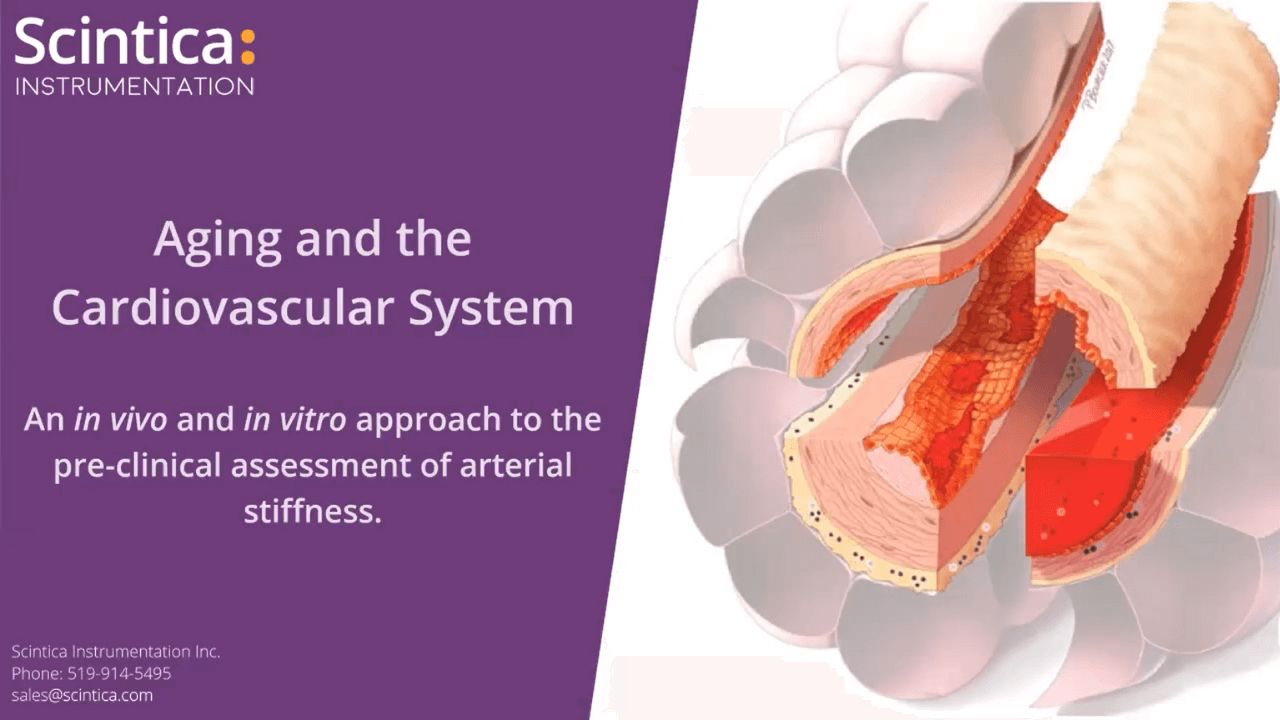(June 10, 2020) WEBINAR: Aging and the Cardiovascular System; An in vivo and in vitro approach to the pre-clinical assessment of arterial stiffness
Almost one third of deaths world-wide can be attributed to cardiovascular diseases (CVD). More than half of those cases are related to systemic arterial hypertension (SAH). There are several risk factors that contribute to the development of SAH. Type II diabetes causes structural and functional damage to arterial walls, which leads to stiffness of compliance vessels and eventually SAH.
Some studies have also related oxidative stress, genetics, and neuroendocrine changes to increasing stiffness. Another risk factor that effects everyone is age, and this webinar will explore the effect of vascular aging and how vascular aging and arterial stiffness can be assessed.
Experimental and clinical studies have demonstrated that changes in small artery structure and function are associated with age. These changes include decreased lumen diameter, increased wall thickness and diminished vasoreactivity. Other risk factors such as hypertension and diabetes accelerate and exacerbate these changes. Quantifying these parameters using isolated and pressurized, perfused, cannulated blood vessels is an ideal way to aid in elucidating the underlying causes of these changes to the vasculature and as they relate to aging and cardiovascular health.
Measuring stiffness in progressive diseases can be challenging, but pulse wave velocity (PWV) is considered the gold standard to assess arterial stiffness in vivo. There is epidemiological evidence of the predictive value of PWV for cardiovascular events, and PWV assessment can be done non-invasively and longitudinally for monitoring the progression and improvement of arterial stiffness through different disease models and treatments. For translational researchers, the PWV measurement technique can be adapted from the traditional clinical technique to be used to assess PWV in preclinical animal research studies. As many of the models for CVD use rodents, PWV in small animals is one of the best ways to monitor treatment efficacy and disease progression for pre-clinical research.
By combining these two modalities, both in vivo and in vitro, researchers can assess arterial stiffness and resulting vascular dysfunction. In this webinar we discussed both methodologies, the techniques and instrumentation used, and some relevant journal articles that use these techniques to assess vascular aging.
This webinar covered the following topics:
- Vascular stiffness, systemic arterial hypertension and other associated effects of aging on the cardiovascular system
- Pulse Wave Velocity (PWV) and Pressure Arteriography and how they can be used to assess arterial stiffness:
- PWV as the gold-standard for longitudinal, non-invasive estimates of arterial stiffness
- Pressure Arteriography and why it is essential for measuring isolated vessel structure and function to assess vascular activity
- A brief summary of relevant literature

About the Speaker (s)

Sarah McFarlane, MSc
Product Manager
Scintica, London, Ontario
Sarah holds an MSc from the University of Western Ontario in Animal Physiology Throughout her academic training she focused on mitochondrial function and the biochemistry of hibernation. In her professional career she has worked with a very diverse range of research applications and technologies, including cardiovascular imaging systems, surgical equipment, tissue oxygenation and vitality monitors, and telemetry. In her present role at Scintica Instrumentation Sarah supports our customers in understanding the products offered and how these instruments help to meet their research needs.

Gus Kalogeros Ph.D.
Product Manager
Scintica, London, Ontario
Gus Kalogeros holds H.BSc. (1991) and a Ph.D. (1998) in Pharmacology and Toxicology, both from University of Western Ontario. His Ph.D. studied the effects of anesthetics and hyperbaric environments on cytosolic calcium in neurons utilizing cellular fluorescence and infrared spectroscopy techniques.
In his previous role as Accounts Manager and Application Specialist with Sonometrics (1999-2020), he acquired extensive knowledge and experience in cardiovascular physiology and invasive experimental instrumentation. In addition to becoming an expert in digital sonomicrometry, he also became proficient with intracardiac/intravascular pressuremetry, ultrasound flowmetry and cardiac volumetry. He worked closely engineers and investigative researchers at medical device companies involved in the design of LVADs, stents and artificial cardiac valves, as well as pharmaceutical companies and institutional research facilities, to provide customized research solutions.
Presently, Gus is at Scintica Instrumention where he serves as Preclinical Product Manager with a focus on products for the cardiovascular physiology laboratory. These products include Doppler flow velocity systems, high-frequency ultrasound, tissue blood/oxygen perfusion monitors, arteriograph/myograph systems and telemetry. His role is to present these technologies to investigators and work with them to meet their research objectives.